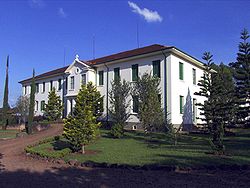Hardehausen-Itatinga Monastery
| Mosteiro de Nossa Senhora da Assunção de Hardehausen-Itatinga | |
|---|---|
 The main building of the Hardehausen-Itatinga monastery |
|
| location | Itatinga , São Paulo , Brazil |
| Lies in the diocese | Archdiocese of Botucatu |
| Coordinates: | 23 ° 6 '44.1 " S , 48 ° 36' 6.4" W |
| Serial number according to Janauschek |
147 |
| Patronage | Assumption Day |
| founding year | 1951 |
| Mother monastery | Hardehausen Monastery |
| Congregation | Brazilian Cistercian Congregation |
The Mosteiro de Nossa Senhora da Assunção de Hardehausen-Itatinga (lat. Abbatia BMV in Caelum Assumptæ de Hardehusio-Itatinga ; German: Abbey Assumption Hardehausen-Itatinga ) is a Cistercian - Abbey in Itatinga , São Paulo , Brazil . The monastery belongs to the Brazilian Cistercian Congregation . Since the canonical rights of the former Hardehausen Monastery have been transferred to the monastery , it is called Hardehausen-Itatinga Abbey .
history
On May 28, 1140, the Hardehausen Monastery was founded in the Paderborn diocese . The monastery existed until it was secularized by the government of the Kingdom of Prussia according to the Reichsdeputationshauptschluss on February 8, 1803 as part of the .
The Marienstatt Monastery , Westerwald , restored in 1888 , endeavored in the early 20th century to repopulate secularized Cistercian monasteries. The Himmerod monastery was restored in 1922. Five years later on May 28, 1927, Hardehausen monastery was repopulated. This was initially set up as a priory and in 1933 was solemnly elevated to an independent monastery. The previous prior of Hardehausen Alfons Heun was elected abbot .
However, the monastery could not hold up in National Socialist Germany. As early as 1938, the order had to give up its efforts. Parts of the convent temporarily went to the St. Agnes Church in Magdeburg as pastors . The abbot and the rest of the convent members went to São Paulo, Brazil, as pastors. The Himmerod Monastery founded its subsidiary Itaporanga Monastery here in 1936 .
On the mediation of Abbot Athanasius Merkle of the Itaporanga Monastery, Henrique Golland Trindade OFM , Bishop of the Diocese of Botucatu , transferred the parish of St. John the Baptist in Itatinga to the Order. With the support of numerous donors, the order was able to acquire a farm here, which it made the starting point for the establishment of a monastery for the members of the Hardehausen convent. The official foundation took place on May 28, 1951, the same date as the foundations of 1140 and 1927. Alfons Heun was again elected as the first abbot of the monastery. The foundation stone of the monastery building took place on August 16, 1951 in the presence of Henrique Golland Trindade and Lucas Nogueira Garcez, the governor of São Paulo. The ecclesiastical rights and privileges of the Hardehausen Monastery were transferred to the newly founded monastery on April 3, 1952, and the old Hardehausen Monastery was thus officially abolished.
Abbot Alfons Heun resigned his position and returned to Germany in 1957. He was succeeded by Roberto Fluck, the prior of the Itaporanga Monastery. During his Abbatiates the Abbey Hardehausen-Itatinga founded together with the monasteries Itaporanga and Jequitibá (State of Bahia ), the Brazilian Cistercian Congregation of Holy Cross. In July 1970 Roberto Fluck took over the presidency of the congregation. In 2018, Father Luis Alberto Ruas Santos is Prior Administrator of the Abbey.
Building description
The monastery is about half a kilometer outside of Itatinga. The buildings of the monastery are grouped around the cloister in a rectangular shape . The residential building is located north of the cloister. A white plastered two-storey house with a hipped roof , the appearance of which is dominated by a central projection on the entrance side . To the south of the cloister is a simple monastery church with a roof turret.
Monastery economy
According to the rules of the Cistercians, the members of the order should live from their own work. The monastery therefore operates extensive agriculture and livestock farming . One of the special products is the “Éclat de nozes”, a confectionery made from nuts and milk . The monastery also sells books. The historic building of the farm, which served as the starting point for the foundation of the monastery, has been converted into a guest house of the monastery.
Web links
- História da Abadia. Retrieved August 13, 2013 .
- Os Monges Cistercienses no Brasil. Retrieved August 13, 2013 .
- PAPA FRANCISCO RECEBEU O DELICIOSO â ???? ECLAT DE NOZESâ ???? DE ITATINGA / SP. Retrieved September 10, 2013 .
Individual evidence
- ↑ Alfons Heun, in: Biographia Cisterciensis (Cistercian Biography), version from January 24, 2011, URL: http://www.zisterzienserlexikon.de/wiki/Heun,_Alfons